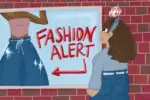In years past, thrifting has been stigmatized, as many people envisioned stale aisles of racks filled with shoulder pads, tacky prints and unflattering cuts from decades ago. The idea of shopping secondhand or consignment turned off many shoppers, as it was considered unfashionable; however, thrifting has recently resurfaced as a trendy alternative.
Over the past few years, thrifting has reemerged as an affordable alternative to traditional shopping. No longer is shopping secondhand viewed as a fashion faux pas, but instead it is both practical and sustainable and provides for a unique look.
Consignment shops and thrift stores have been around for decades with the first modern thrift store, or “charity shop,” opening in 1937 in Edinburgh, Scotland under the supervision of the Edinburgh University Settlement. Since then, consignment stores have spread across the world. Thrift shops’ newest evolution brings them to the forefront of e-commerce. Amongst the swells of new online retailers, online thrifting is a welcome change of pace.
As consumers become increasingly more environmentally conscious, companies in all industries are forced to reconsider their environmental and societal impact. Thrifting offers a relatively simple solution to many of fashion’s issues concerning the environment. Clothing companies have taken various approaches to the online thrifting market, with some models centralizing into one main retailer while others attempt to mesh thrifting and social media.
Regardless, each of these companies is carving out a niche for themselves in the realm of online thrifting by catering to modern consumers’ demands for both sustainability and frugality.
The most notable of these social marketplaces is Poshmark. Poshmark is a community-based platform for buying and selling clothes, as well as home goods. While some of these products are from boutiques and can be bought brand new with tags, the majority of the product on Poshmark is secondhand.
The website’s home page claims that it is “#1 way to buy and sell fashion” with millions of users from around the world. The site boasts over 50 million total users with an included 5 million sellers.
In the buying and selling process, Poshmark simply serves as the middleman. In addition to the Poshmark marketplace, the site also offers a stylist service that matches users to other stylists on the platform. With so many users, the supply of goods that the website presents is incredibly broad.
Shoppers can find anything from your dad’s grass-stained New Balances to vintage Louis Vuitton handbags. Other companies, like Depop, have taken note of Poshmark’s success and have also entered the pseudo-social media niche of online thrifting.
https://www.instagram.com/p/B3ZqQ_SB25Z/
Another popular secondhand website is thredUP. ThredUP is the largest online secondhand shopping destination, with over 15,000 styles added every day. ThredUP’s model embraces a warehouse approach to online thrifting. Instead of featuring individual accounts with buyers and sellers, thredUP condenses their supply at their packing centers and then packages and ships the product to consumers. Their website looks more like a familiar, traditional retailer than anything else.
The search function features a variety of filters and lists which allows for easy browsing and there are even categories for maternity and children. Users also have the opportunity to either sell or donate to thredUP in order to upcycle their closets. Additionally, by utilizing this warehouse model, thredUP is able to individually authenticate and vet each item that is sent to them.
Their website claims, “No knockoffs here — just knockoff prices.” Similarly to Poshmark, with so many items being added every day, thredUP presents an incredible number of brands and styles. Over 35,000 brands are represented on thredUP’s website. Users are also able to buy some of their favorite brands at prices as low as 90% off.
✨Retweet and share with your fellow thrifters. 👯♀️😍 pic.twitter.com/5ImHJdeFJB
— thredUP (@thredUP) October 14, 2019
Goodfair, out of all the online consignment shops, has probably embraced the thrifting spirit the most. On their website, customers simply choose their size and what article of clothing they would like to purchase, and then Goodfair will send them a random item that fits those specifications. While this might seem silly to someone who is accustomed to buying their clothing firsthand, for the environmentally conscious consumer, Goodfair offers a pretty good deal.
Along with their clothes’ vintage, hipster aesthetic, they argue that by cutting out the production costs of photographing individual products, Goodfair is able to keep prices low while, in some ways, offering a more authentic thrifting experience. The act of opening up a package not knowing what lies inside simulates the excitement of finding a hidden treasure at a traditional thrift shop. After all, who doesn’t like a good surprise? Plus, retro is always cool.
Our Philosophy: Recycled Goods, Low Prices. Eliminating Waste, Full Transparency. pic.twitter.com/aNka4Qv75A
— Goodfair (@Goodfair_) October 9, 2019
Contrary to the idea of thrifting, the advent of fast fashion in the 1990s created shopping mall staples such as Forever 21, H&M and Zara. Fast fashion, while detrimental to the environment, conditioned the American consumer to seek out lower and lower prices for new fashion styles at a quicker rate. Fast fashion brands create new, trendy styles at an extremely rapid pace that not only causes major environmental effects, but also results in the cheap use of sweatshop labor.
Goodfair, and many other companies like it, seek to combat both fast fashion’s labor practices and environmental effects. After all, after oil, fashion is the second most polluting industry in the world: 26 billion pounds of clothing are thrown into landfills every year and it takes 700 gallons of water to produce a single T-shirt.
As demonstrated by Forever 21 filing for bankruptcy in September, the increasing presence of online shopping and emphasis on sustainability is forcing fast fashion brands to rethink their business models and presence in the retail market. Online thrifting websites like Poshmark, thredUP and Goodfair provide both variety and sustainability at a reasonable price, while also keeping the spirit of thrifting and consignment alive.
https://www.instagram.com/p/B3kskjqlpHG/?utm_source=ig_web_copy_link
While going to an actual thrift store still has its charm, online thrifting is a convenient substitute. Ultimately, online thrifting is worth trying out because it offers an alternative to shopping that is not only economical, but also sustainable to consumers.

















Everyone loves it whenever people come together and share thoughts.
Great website, stick with it!